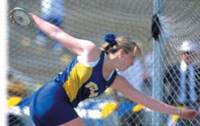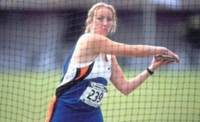SUZY POWELL: A Date with DestinyWhen the world turns its focus on the Olympic Games this year, Suzy Powell hopes to earn its applause.By Kim Goss Published: Summer 2000 Whether the figure is on a stamp, a statue or stationery, the discus thrower has always been the athlete of choice to represent the Olympic Games. Perhaps it’s the combination of skill and power that has attracted us to the discus event over the centuries. Perhaps it’s the way the athlete’s body flexes in absolute preparation to use every muscle in the body in one maximum effort. Whatever the reason, we have always been fascinated by the discus thrower. And this year, at the Olympic Games, one athlete who wants to assure her place in the mystique of the discus is Suzy Powell. Suzy is one of America’s premier discus throwers and has the third all-time best in the event in the U.S. with an even 214 feet. This season Suzy believes she may be able to throw as far as 220, a distance that would shatter the current American record held by Carol Cady by four feet. But getting in the record books is not all that matters to Suzy, as those big numbers must be made in the right place at the right time. “First and foremost, my goal is to make the Olympic team in July,” says Suzy. A native of Modesto, California, Suzy graduated last September from UCLA, earning a degree in geography with a minor in business. Suzy would like eventually to attend graduate school in business, but that goal has to be put on hold as she peaks for the Olympic Trials in July. With a schedule that consumes as much as five hours of training six days a week, she has little time to concentrate on much else. The Start of Someone Good Coming from an athletic family that includes a sister and four brothers, Suzy has always been physically active. Her first major organized sport was soccer, but when she got into track it was primarily as a distance runner. “Then my dad had me try the discus, because he’s always liked the event and knew I had a good arm. I was really reluctant because I didn’t think throwing was a very exciting sport, but once I tried it and found I was really good at it, I became motivated to stay with it.” In junior high Suzy says gave up soccer to concentrate on track and basketball—basketball, as she says, “because I knew that at 5’11” I was going to be a better basketball player than a soccer player. She stuck with both track and basketball until the end of her senior year at Thomas Downey High School, but decided it would be best to give up basketball at UCLA. “It was a very difficult decision for me to quit basketball when I was in college, but I knew it was going to be too hard to do both, and I felt I would have more success as a discus thrower.” At UCLA Suzy’s roommate was Amy Acuff, a high jumper who was featured in the Fall 1998 issue of BFS. Despite both women’s intense academic programs at UCLA (Amy’s major was biology to prepare for medical school), both athletes quickly climbed the national rankings in their respective events. “In college it’s a little easier to make progress because you have such a good support system of trainers, coaches and other athletes,” says Suzy. “It’s an ideal situation” Coaching From the Heart Although she’s had many excellent coaches in her career, including Art Venegas at UCLA, Suzy’s primary coach and number one fan is her father, Mack. “My dad is an engineer, so he’s pretty analytical with a very good understanding of physics—and of me, which might be more important than anything else.” Was it tough having a dad as a coach? Suzy replies, “Not anymore. When I was in seventh and eight grade we had our little bouts, because it was hard to separate dad from coach.” With her accomplishments on the field, younger throwers have much to learn from Suzy. “My first piece of advice would be to take the time to learn the technique properly. A mistake a lot of throwers in high school make is trying to jump right into the spin—so don’t rush into that. Also, the women’s discus is quite a light implement at 2.2 pounds [1 kilo]. The better flexibility you have in your chest and your shoulders, the better stretch you’re going to get off your chest, and that’s how the discus is thrown. Obviously the legs and hips are the main source of the power, but as far as the delivery goes it’s the chest that leads.” In the area of strength training, Suzy’s biggest influence is her current strength coach, John McBride of the University of the Pacific. “He gave me my first real introduction to weightlifting. He showed me how to do cleans and snatches, the proper technique for the squat, and he wrote my workouts.” When you speak with Coach McBride, it’s obvious he tries to take care of every aspect of training and puts considerable time into developing his programs. He divides his training into 12-week cycles, which are broken down further into 4-week cycles. For the discus, he has Suzy concentrate on the power snatch and the power clean, the push press and the push jerk, the incline bench press (which he prefers over the flat bench press because of the angle of the release of the discus), and of course squats. Says Coach McBride, “If you want to be a great athlete, you have to clean and squat.” When asked about the differences in training male and female athletes, Coach McBride replied, “That’s a challenging question. Physiologically, women have relatively longer femurs (upper thigh bone), so their squatting techniques tend to be a little bit different, but that’s a minor point. I really don’t look at our athletes much differently. I treat every athlete fairly and as an individual, which means some athletes need a kick in the butt and some need an arm around the shoulder.” Concerning Suzy, Coach McBride is impressed with her discipline, motivation (she drives 45 miles, three times a week to train with him), and appreciates that she often takes time to talk to his other athletes about training and what it takes to be a champion. Although her best lifts include a 132-pound power snatch, a 198x2 power clean, a 235x2 squat with a Manta Ray. For Suzy, the only disappointing aspect of throwing the discus may be that it’s more popular overseas than in the United States “The European perspective is different, and they are more knowledgeable about the sport. The media focus less on human interest stories and more on the straight meet.” Although she is receiving sponsorship from Advocare and Asics, after the Olympics Suzy sees herself concentrating on the European track circuit. “Our athletes obviously have to go over there because that’s where the money is, but everyone would like to be appreciated in their home country.” Suzy Powell may not look like the emblematic male Greek statues and figures we’ll see on Olympic posters, but with her smart training and exceptional talent, you can bet her accomplishments will be chiseled in history. |
 |
|
Suzy Powell cocking back at the start of her spin. Her best discus throw so far has been 214 feet. |
 |
|
Suzy is one of America’s premier discus throwers and has the third all-time best in the event in the U.S. with an even 214 feet. |
 |
|
Although the Discus is Suzy’s featured throw, she also throws the Javelin. Suzy’s advice to new throwers, “Take the time to learn technique properly.” |